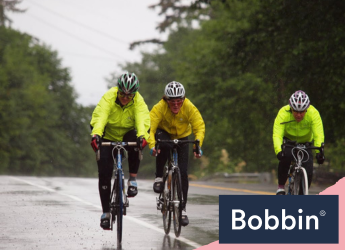Cycling in the Rain: Key Tips for a Safe Ride
Cycling in the rain on Bobbin bikes can be quite an adventure. But before you go this route, you’ll need to prepare to make it more enjoyable and safer. In this blog, we’ll share some suggestions to get you started. These tips can be helpful whether you’re caught off guard by unexpected rain or intentionally riding for training or new experiences.
Dress Smart When Cycling in Wet Weather

You’re sure to get wet, that’s a given, but if you dress right, you can cycle comfortably in the rain. Set aside your usual cycling shirt and trousers and reach for waterproof and breathable alternatives. These garments use a dual-layer system and a fabric coating to prevent you from getting wet from the inside.
Layering your cycling clothing also helps regulate your body temperature. The base layer wicks away sweat, keeping you dry and comfortable. The mid-layer traps heat to keep you warm, while the outer layer protects you from wind and rain.
Don’t forget about your hands and feet! It’s always a good idea to wear full-finger gloves. These will help you grip a wet handlebar and prevent your hands from getting numb due to the cold and wet. Wearing overshoes provides an additional layer of protection for your feet. They keep them warm and dry, preventing water and cold air from coming into your shoes.
Check out our list of winter cycling clothes for more ideas.
Something for Your Eyes for a Clear Sight
Glasses with hydrophobic coatings are a worthwhile investment and addition to your cycling wardrobe. These coatings repel water, meaning raindrops will easily slide off the lenses. This, overall, ensures better visibility during rainfall.
Paired with a helmet visor, they can keep the rain away from the lenses, saving you from wiping frequently. With a consistent, clear view, you can navigate through raindrops and wet roads with convenience. Always pack something for your eyes, even when cycling in autumn or summer.
Adjust Your Riding Technique

Riding in the rain requires slower speeds for safety. For first-timers, be extra cautious. Simply cycle slowly and brake carefully to maintain control over your bike. For instance, when braking or cornering, slow down and be careful not to lean forward too far when turning.
Ride in a straight line to avoid slips and falls on wet terrain with a hybrid bike. Pay attention to other road users and increase your following distance from them. Doing so gives you ample reaction time in unpredictable conditions.
To stay in control, steer clear of puddles and places that often flood. Also, watch out for hydroplaning on wet streets. Hydroplaning occurs when your bike skims over the water instead of gripping the road. It can make steering tough and raise the chance of accidents.
Tip: Consider taking a different route and have a plan B. Suppose the path you usually take is wooded or unpaved. It can present new obstacles in the rain, even if you know every inch of it.
Get Your Bike Rain-Ready
Get your adult bicycle ready for rain by taking the time to do these maintenance tasks before hitting the wet road:
- Check and lubricate the chain regularly to prevent corrosion, friction, and wear. Oiling the chain maintains efficient power transfer from the pedals to the wheels. Read our guide, ‘How to Oil a Bike Chain,’ to learn more.
- Inspect brakes and make necessary adjustments for optimal performance and reliable stopping power.
- Confirm that your tyre pressure is suitable for wet conditions, providing better traction.
Explore these bicycle adjustments for more upkeep guidance.
Make Yourself Highly Visible

(Image Credit: Wikimedia Commons)
You’ll want other cyclists and road users to be able to spot you from a distance. This is especially important as roads can be extra hazardous in the rain. To stay visible, wear clothing with reflective elements; it could be a jacket, shoes, or your Bobbin helmet. This will make you more noticeable during a foggy, rainy ride.
Adding reflective accessories like stickers or tape on your bicycle also helps. This further catches the attention of drivers and fellow cyclists. Also, use bike lights, such as front and rear, even in daylight hours, to increase your visibility from a distance.
Round-up
Learning how to bike in the rain can make your rides safer and more enjoyable. Using these ideas, your rainy rides can be confident and safe. So grab your gear, be visible, and ride confidently in the rain. Remember, a little preparation can make biking fun, even in different weather!
For intermediate and advanced cyclists we also have a guide on mastering wet weather cycling.
Consider wearing a Bobbin helmet for head protection during rides. Additionally, use bike accessories like bike bells to alert others of your presence.
Up next on your reading list: Tips for Cycling on a Hot and Sunny Day
FAQ
Is it OK to ride my bike while it’s raining?
Yes, it’s okay to ride your bike in the rain. Ensure safety by wearing appropriate gear, like waterproof clothing. Additionally, use lights for visibility and adapt your riding technique to wet conditions.
How do you stay dry when riding a bike in the rain?
To stay dry while riding in the rain, wear waterproof and breathable clothing. Use fenders to deflect water, and consider a bike rain cover. These measures help keep you comfortable during wet weather rides.
How do I keep my feet dry when cycling in the rain?
Keep your feet dry by wearing waterproof shoe covers or overshoes. Choose shoes with water-resistant features. Avoid puddles to minimise the risk of water seeping into your footwear while cycling in the rain.








